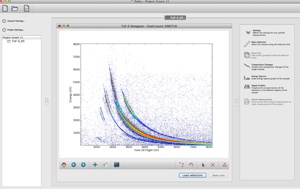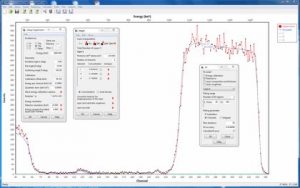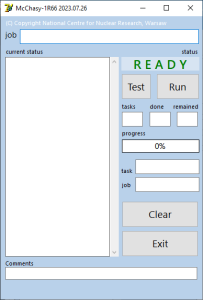Ionbeamcenters.eu aims to give users a comprehensive overview of existing ion beam data analysis software as well as ion beam simulation software for ion irradiation and ion beam transport and tuning. If you would like your software to be listed here, please contact us at .
Ion Beam Analysis Software
ANN - Artificial Neural Network Software
An artificial neural network algorithm is developed for the simultaneous analysis of multi-detector RBS depth profiling. This approach allows a push-button instantaneous analysis of large multi-detector data sets with a high accuracy. Moreover, this approach avoids user-bias and reduces the ambiguity of RBS in data interpretation. This algorithm was developed by Goele Magchiels at the KU Leuven, BE.
BATS - AMS Data Analysis Program
BATS is a program to analyse data of AMS measurements for 14C and many other AMS nuclides.
For access to BATS, please contact Christof Vockenhuber at the ETH Zurich
CORTEO - Monte Carlo simulation program
Corteo does MC simulations of ion beam analysis spectra within a few seconds or minutes and can be used for RBS, ERD, RBS-TOF, ERD-TOF, and coincidence of identical ions. Corteo computes the trajectory of ions in materials, based on binary collision, central potential, and random phase approximations.
Corteo was developed by François Schiettekatte at the Département de physique, Université de Montréal, Canada.
Available for free at Université de Montréal
CrystalDraw - Visualisation of RBS-channelling experimental set up
CrystalDraw visualises a crystal structure from .CIF files, generates stereographic projections and allows rotations around. CrystalDraw was developed by Jonathan England at the University of Surrey, UK.
Please contact Jonathan England at the University of Surrey for access to CrystalDraw.
DICADA
Calculation of channelling RBS spectra of single crystals for given defect distribution (displaced lattice atoms, some other types of defects), and vice versa.
Free use of the executable code after signing a license agreement. Please contact Elke Wendler at Uni Jena for access.
GUPIXWIN
GUPIXWIN is a program for fitting PIXE spectra from thin, thick, intermediate and layered specimens. GUPIXWIN extracts peak intensities and converts these to concentrations via the H-value standardization method. X-ray excitation may be via protons, deuterons, He-3 or He-4 ions; X-ray spectrometry may be via SDD, Si(Li) or Ge detectors. Interactive or batch. GUPIXWIN is maintained and developed by J. L. Campbell, Department of Physics, University of Guelph, Canada.
Available for purchase at Department of Physics, University of Guelph
JaBS
JaBS is a program to simulate RBS, ERD and NRA spectra rapidly. It was developed by Jaako Julin.
More information is available on the GitHub page or directly from Jaako. The code is available for all major platforms (Windows, Linux, macOS).
Available from https://github.com/JYU-IBA/jabs as open source (GPL 2).
JIBAL
JIBAL, the Jyväskylä Ion Beam Analysis Library, provides stopping forces, straggling models, cross sections and various atomic data e.g. masses and abundances for typical IBA applications. It was developed by Jaako Julin and is open source (GPL 2).
More information is available on the GitHub page or directly from Jaako. The code is available for all major platforms (Windows, Linux, macOS).
Available from GitHub: https://github.com/JYU-IBA/jibal
McChasy-1: Monte Carlo CHAnneling SYmulation software
McChasy-1 is dedicated to the analysis of Rutherford Backscattering/Channeling (RBS/C) data. Monte Carlo simulations (a trial-and-error approach) are used to reproduce trajectories of light ions in crystalline materials containing selected defect types (e.g., randomly displaced atoms, substitutions, dislocations and/or dislocation loops). Separate defect profiles can be determined for satisfactorily fitted RBS/C spectra.
McChasy-1 is available for free on request from the website McChasy | National Centre for Nuclear Research (ncbj.gov.pl). For more information please contact:
MergeSpectra
Merge various RBS spectra from a multi-detector setup that have a slightly varying energy calibration.
Free use of the executable code for non-commercial usage after signing a license agreement. Please contact Niels Claessens at imec for access.
MSA - Mass Spectra Analysis
Mass Spectra Analysis (MSA) allows the analysis and transformation of a 2 dimensional ToF-ERDA spectra into a 1 dimensional mass spectrum.
For access to MSA, please contact Christof Vockenhuber at the ETH Zurich
NDF - General purpose code for data analysis of Ion Beam Analysis Data
NDF is a DOS code dedicated to the analysis of RBS, ERDA, PIXE, non-resonant NRA and NDP data for any ion, any target, any geometry, and number of spectra. The full version includes a recent SIMS addition, local search fitting, simulated annealing fitting and Bayesian inference. NDF was developed by Nuno Pessoa Barradas at Instituto Superior Técnico (IST), Universidade de Lisboa, Portugal.
Available as Open Source at the University of Lisboa. Open source components. For details, contact Nuno Pessoa Barradas.
Potku
Potku is a graphical user interface for processing and analysis of list-mode data; Monte Carlo simulation of ERD energy spectra including multiple and plural scattering effects and detector performance. Potku is currently maintained and developed by University of Jyväskylä‘s Accelerator Based Materials Physics group at the Accelerator Laboratory.
Potku is an open source analysis software and can be used to
- perform time-of-flight calibration
- study composition changes over the length of the measurement
- create energy spectra from time-of-flight spectra (to export measurement to other software
- create depth profiles
- MCERD simulations and compare the measured ToF-ERDA data to simulated data
- automatically fit the simulated composition profile to match the experimental profiles

Available for free at www.jyu.fi
PowerMEIS
Monte-Carlo-type software for the simulation of MEIS/RBS/EBS/NRA spectra. Created by G.G. Marmitt.
Direct web access at http://tars.if.ufrgs.br
RUTHELDE
RUTHELDE is an open source software package for the simulation of RBS spectra and the automated target model fitting based on an evolutionary algorithm. It further allows to determine uncertainties of RBS measurements and comes with handy tools like stopping calculator, IBA kinematics calculator and ion penetration depth plotter.
RUTHELDE is written in JAVA programming language and this runs on any operation system. Within the GiHub repository pre-build binaries are included for download.
Further information on the code and its capabilities can be found in:
Heller, N. Klingner, N. Claessens, C. Merckling, J. Meersschaut, J. Appl. Phys. 132, 165302 (2022) https://doi.org/10.1063/5.0096497
Open Source Software at https://github.com/DrReneHeller/Ruthelde
SIMNRA - Simulation of RBS, ERDA, NRA, MEIS and PIGE
SIMNRA is used for the evaluation of ion beam analysis data and was developed by Matej Mayer at the Max-Planck-Institute for Plasma Physics, Garching, Germany. SIMNRA supports the simulation of Rutherford backscattering spectrometry (RBS), elastic backscattering spectrometry with non-Rutherford cross-sections (EBS), nuclear reaction analysis (NRA), elastic recoil detection analysis (ERDA), medium energy ion scattering (MEIS), and particle induced gamma-ray emission (PIGE).
Shareware, 30 day free trial version available at https://www2.ipp.mpg.de/~mam/

SPACES - Simulation of narrow resonance excitation curves
Simulation of excitation curves obtained around narrow resonances in nuclear reaction cross sections, within the stochastic theory of charged particle stopping, from samples of arbitrary depth composition.
Please contact Ian Vickridge at INSP for access to SPACES.
SPECTOR – Processing of ion beam analysis data
SPECTOR is a graphical user interface for histogram generation, manipulation and analysis of RBS, ERDA, PIXE, SIMS and IBIC spectra. Additionally, it features the replay of list-mode data and data export to ASCII format. It was firstly introduced in 1995 by Mladen Bogovac. Presently, Donny Domagoj Cosic is working constantly on its further developments and adjustments for new requirements.
For further information and access to SPECTOR, please contact at Ruder Bo`´skovi´c Institute (https://www.irb.hr).
SPECTRERDA
SPECTRERDA is an ERDA analysis and conversion software developed at ETH Zürich.
For access to SPECTRERDA, please contact Christof Vockenhuber at the ETH Zurich
TFU_to_nm - Interpretation of IBA results
GUI to convert results from IBA to physical thickness assuming mass density. Developed by Johan Meersschaut at IMEC.
Please contact Johan Meersschaut at IMEC for access to TFU_to_nm
Ion-Solid Interaction Software
CIRILION
Simulation of the spatial distribution of the ionizing events around the swift ion path. Monte-Carlo simulation of ion interaction with target electron and 3D dynamic Monte-Carlo of electron cascade. CIRILION was developed by CNRS – CIMAP and GANIL.
Please contact Serge Bouffard at GANIL for access to CIRILION
Crystal-TRIM - Simulation of Ion-Solid Interactions
Monte-Carlo simulation of ion irradiation effects (ion ranges, sputtering, damage formation) in single crystalline Si, Ge, C based on the binary collision simulation, including model of dynamic damage accumulation. Crystal-TRIM was developed by Matthias Posselt at Helmholtz-Zentrum Dresden-Rossendorf e.V., Germany.
The licensing procedure for the transfer of the executable code is explained on the webpage at HZDR.de
FLUX7
Flux7 simulates the trajectories of high energy ions in single crystals in a channeling or near- channeling direction using the binary collision approximation. The effective flux density across the lattice plane is evaluated. FLUX7 was developed by Peter Smulders.
Free download at http://www.pjms.nl/FLUXHTML/
IMSIL
IMSIL (Implant and Sputter sImuLator) is a Monte Carlo simulator of ion irradiation effects based on the binary collision approximation. It can handle static 1D, 2D, and rotational symmetric 3D target geometries composed of an arbitrary number of amorphous material and optionally one crystalline material. In addition, dynamic changes to geometry and composition of 1D targets can be simulated.
For further information see https://www.tuwien.at/en/etit/fke/research/process-simulation
iradina - ion range and damage in nanostructures
Fully 3D static Monte-Carlo simulation of ion irradiation effects (ion ranges, sputtering, ion mixing, damage formation) based on the binary collision simulation.
Free download from University of Jena
Kalypso
Kalypso is a molecular dynamics software package for simulation of atomic collisions in solid targets and at surfaces. Kalypso was developed by Marcus Karolewski.
Free download at https://sites.google.com/site/kalypsosimulation/
Molecular Dynamics for Supported 2D Materials
A LAMMPS based molecular dynamics script allows to simulate ion irradiation of 2D Materials on a substrate in an efficient way. As an example, a modified Stillinger-Weber potential for MoS2 in combination with the ZBL potential is implemented. For interaction with the substrate, an external potential is added in LAMMPS, and energy and angle distributions of atoms emitted from the substrate (backscattered ions and sputtered substrate atoms), as generated by TRIDYN simulations, are taken into account. The LAMMPS and TRIDYN scripts were developed by Silvan Kretschmer at Helmholtz-Zentrum Dresden-Rossendorf.
Contact Silvan Kretschmer for details and the use of the code.
SDTrimSP
SDTrimSP (Static and Dynamic Trim for Sequental and Parallel computer) is a 1D/2D/3D dynamic Monte-Carlo simulation of ion irradiation effects (ion ranges, sputtering, ion mixing, damage formation) based on the binary collision simulation. SDTrimSP was developed by the Max-Planck Institute for Plasma Physics.
SDTRimSP is available from Max-Planck-Innovation. A single user license is 500€, a campus license is 1000€.
SRIM - The Stopping and Range of Ions in Matter
SRIM is a collection of software packages to calculate different features of the transport of ions in matter. Applications of the software include Ion Stopping and Range in Targets, Ion Implantation, Sputtering, Ion Transmission, and Ion Beam Therapy. SRIM was developed by James F. Ziegler.
Downloadable for free at http://www.srim.org/
SUSPRE - Ion implantation calculator
SUSPRE does fast predictions of ion ranges, sputtering yields, and damage. It is designed to calculate the implantation range profiles of any ion in any target material. SUSPRE was developed by Roger Webb at the University of Surrey.
Downloadable for free from the Ion Beam Centre at the University of Surrey
TRIDYN - Simulation of Ion-Solid Interaction
1D dynamic Monte-Carlo simulation of ion irradiation effects (ion ranges, sputtering, ion mixing, damage formation) based on the binary collision simulation. TRIDYN was developed by Wolfhard Möller at Helmholtz-Zentrum Dresden-Rossendorf e.V., Germany.
The licensing procedure for the transfer of the executable code is explained on the webpage at HZDR.de
TRI3DYN - Simulation of Ion-Solid Interaction in 3D systems
Fully 3D dynamic Monte-Carlo simulation of ion irradiation effects (ion ranges, sputtering, ion mixing, damage formation) based on the binary collision simulation. TRI3DYN was developed by Wolfhard Möller at Helmholtz-Zentrum Dresden-Rossendorf e.V., Germany.
Information on how to get TRI3DYN as well as application examples can be found at hzdr.de.
